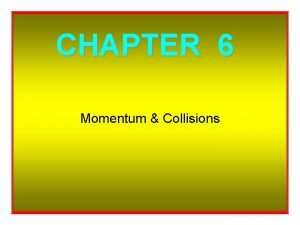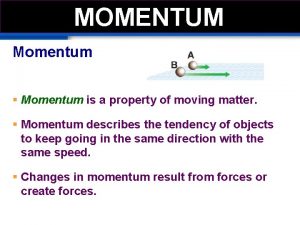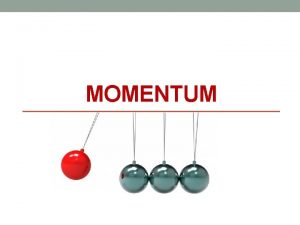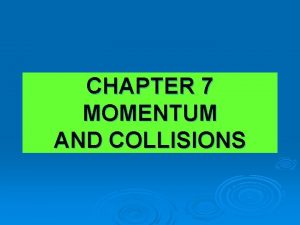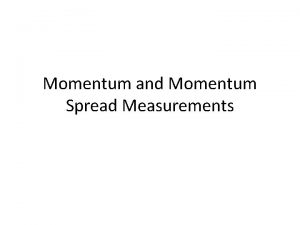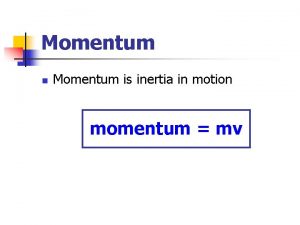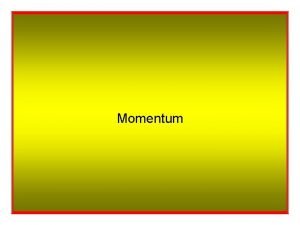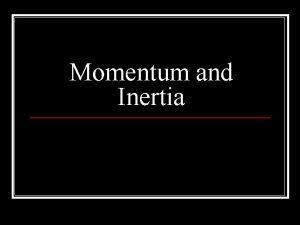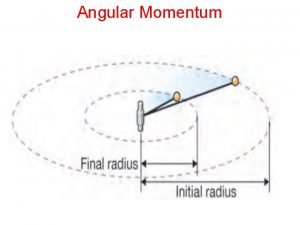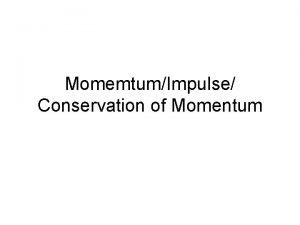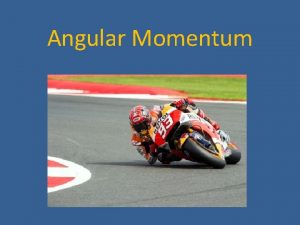Momentum Introduction to Momentum What is Momentum The































- Slides: 31

Momentum Introduction to Momentum

What is Momentum? • The quantity of motion of a moving body • Depends on mass and velocity • Measured by multiplying mass to the velocity • Vector • Measured in kg*m/s or N*s

How is momentum measured? • Momentum = mass x velocity • p=m. V – p=momentum – m=mass (kg) – V=velocity (m/s)

Example • Calculate the momentum of a 6. 2 kg pumpkin traveling at a velocity of 5. 0 m/s west.

Clicker Question • A baseball of mass 0. 14 kg is moving at 35. 0 m/s. Find the momentum of the baseball. • A)4. 9 • B)1. 4 • C)35 • D)250

Clicker question • Find the velocity of a bowling ball with a mass of 7. 6 kg and a momentum of 4. 9 kg m/s. • A)283 • B)37. 2 • C)0. 64 • D). 20

Impulse-Change in Momentum • When an object stops or changes its velocity the momentum changes • Δp=mΔV • Or Δp=m(Vf-Vi)

Example • A 0. 50 kg water balloon is thrown against a wall at 32 m/s coming to a stop. What was its change in momentum?

Clicker Question • A 0. 50 kg bouncy ball is thrown at 32 m/s, bouncing back with the same speed. How does its change in momentum compare to that of the water balloon? • A) -32 kg m/s so twice as large • B) There is no difference • C) There is 0 change in momentum

Momentum-Impulse Theory

What is impulse? • It is the change in momentum (Δp) • Δp=mΔV or m(Vf-Vi) • The impulse-momentum theorem states that when a net force is applied to an object over a certain time interval, the force will cause a change in the object’s momentum. • So Impulse can be defined as the product of the force and the time in which the force is acting on an object • Δp=FΔt • So… FΔt=mΔV

Example • Luigi is sick of taking orders. He swings a 9. 0 kg hammer at 16 m/s when Mario’s mustache brings it to a stop in 0. 25 s. What is the net force exerted on Mario’s mustache?

Clicker Question • A soccer player kicks a 0. 450 kg ball at 25. 0 m/s east. If the goalie stops the ball by exert 215 N of force, how long does it take the ball to stop? • A)2418 s • B)0. 052 s • C)3 s • D)1 s

Clicker Question • If the goalie stops the 6. 5 kg bowling ball traveling at the same velocity in the same amount of time, how much force is required? • A)6000 • B)3250 • C)2000 • D)1000

Discuss • Coaches for many sports such as baseball, tennis and golf can often be heard telling their athletes to “follow through” with their swing. How does this help a weaker player hit a ball farther than a stronger player? • Use the momentum-impulse theory

Discuss • Using the principle of impulse, explain why an airbag can help people sustain less damage during a collision.

Momentum Law of Conservation of Momentum

Recall • Newton’s 3 rd Law • Every action force has an equal and opposite reaction force • Two colliding objects experience equal and opposite forces for the same amount of time, then their impulses must be equal and opposite

Example • A cue ball is traveling with a momentum of 5 kg m/s east and strikes the 8 ball. If the cue ball comes to a stop what is the change in momentum on the cue ball? How about on the 8 ball?

Example • A clown is stuck on a sheet of frictionless ice. He hurls one of his clown shoes with momentum of 80 kg m/s east. What is his momentum before and after he throws his shoe?

• A fullback is traveling to the right with a momentum of 120 kgm/s while a linebacker is traveling to the left with a momentum of 110 kgm/s. If they stick together, what is their total momentum before and after they collide

Law of Conservation of Momentum • In an isolated system, momentum is not created or destroyed during any interaction (collision) • An isolated system means no external forces act on the system • Total initial momentum = Total final momentum • pi=pf • m 1 V 1 i + m 2 V 2 i = m 1 v 1 f + m 2 V 2 f

Elastic Collision • A collision in which the total momentum and the total kinetic energy are conserved is called an elastic collision • The objects will separate from each other after the collision • m 1 V 1 i + m 2 V 2 i = m 1 v 1 f + m 2 V 2 f

Example • A 7. 1 kg bowling ball is rolling to the right at 3. 8 m/s when it collides with a stationary 0. 40 kg bowling pin. After the collision, the bowling ball is traveling at 2. 9 m/s to the right. How fast is the pin moving after the collision?

• A 0. 25 kg cue ball is traveling east at 4. 5 m/s when it collides head on with a 0. 25 kg eight ball traveling west at 5. 0 m/s. After the collision the cue ball Is traveling west at 2. 0 m/s. What is the final velocity of the eight ball A) 4. 5 m/s B) 1. 5 m/s C) 9. 5 m/s D) 2. 0 m/s

Inelastic Collisions • A collision in which two objects stick together after colliding and move together as one mass is called a perfectly inelastic collision. • m 1 V 1 i + m 2 V 2 i = (m 1 + m 2)Vf

Example • A 0. 105 -kg hockey puck moving at 48 m/s is caught by a 75 -kg goalie at rest. If the ice is frictionless, at what velocity will the goalie slide on the ice after catching the puck?

Clicker Question • A 35. 0 -g bullet strikes a 5. 0 -kg stationary wooden block and embeds itself in the block. The block and bullet move together at 8. 6 m/s. What was the original velocity of the bullet? • A) 12 m/s • B) 9. 9 m/s • C) 1200 m/s • D) 40 m/s

Explosions • In a situation in which you have one object separate into pieces • The initial momentum is zero • The law of conservation will still apply here • 0 = m 1 v 1 f + m 2 V 2 f

Example • A 0. 050 kg bullet is fired from a 5. 0 kg gun. If the velocity of the bullet is 275 m/s, what is the recoil velocity of the gun?

Clicker Question • A firecracker sits in a 7. 0 kg pumpkin. After It explodes, the pumpkin splits into two chunks. A 5. 0 kg piece travels west at 10. 0 m/s. What is the mass and velocity of the other piece? (Ignore the mass of the firecracker) A) 25 m/s B) 40 m/s C) 10 m/s D) 50 m/s
 Conceptual physics momentum
Conceptual physics momentum Hình ảnh bộ gõ cơ thể búng tay
Hình ảnh bộ gõ cơ thể búng tay Bổ thể
Bổ thể Tỉ lệ cơ thể trẻ em
Tỉ lệ cơ thể trẻ em Voi kéo gỗ như thế nào
Voi kéo gỗ như thế nào Glasgow thang điểm
Glasgow thang điểm Chúa sống lại
Chúa sống lại Các môn thể thao bắt đầu bằng tiếng chạy
Các môn thể thao bắt đầu bằng tiếng chạy Thế nào là hệ số cao nhất
Thế nào là hệ số cao nhất Các châu lục và đại dương trên thế giới
Các châu lục và đại dương trên thế giới Công thức tiính động năng
Công thức tiính động năng Trời xanh đây là của chúng ta thể thơ
Trời xanh đây là của chúng ta thể thơ Mật thư anh em như thể tay chân
Mật thư anh em như thể tay chân Làm thế nào để 102-1=99
Làm thế nào để 102-1=99 độ dài liên kết
độ dài liên kết Các châu lục và đại dương trên thế giới
Các châu lục và đại dương trên thế giới Thơ thất ngôn tứ tuyệt đường luật
Thơ thất ngôn tứ tuyệt đường luật Quá trình desamine hóa có thể tạo ra
Quá trình desamine hóa có thể tạo ra Một số thể thơ truyền thống
Một số thể thơ truyền thống Cái miệng bé xinh thế chỉ nói điều hay thôi
Cái miệng bé xinh thế chỉ nói điều hay thôi Vẽ hình chiếu vuông góc của vật thể sau
Vẽ hình chiếu vuông góc của vật thể sau Nguyên nhân của sự mỏi cơ sinh 8
Nguyên nhân của sự mỏi cơ sinh 8 đặc điểm cơ thể của người tối cổ
đặc điểm cơ thể của người tối cổ Thế nào là giọng cùng tên
Thế nào là giọng cùng tên Vẽ hình chiếu đứng bằng cạnh của vật thể
Vẽ hình chiếu đứng bằng cạnh của vật thể Tia chieu sa te
Tia chieu sa te Thẻ vin
Thẻ vin đại từ thay thế
đại từ thay thế điện thế nghỉ
điện thế nghỉ Tư thế ngồi viết
Tư thế ngồi viết Diễn thế sinh thái là
Diễn thế sinh thái là



































